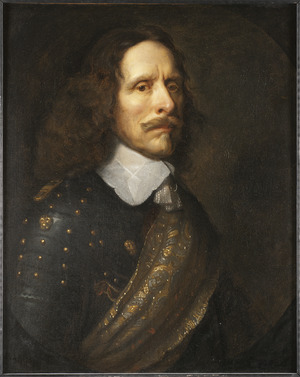Gustav Horn, Count of Pori facts for kids
Quick facts for kids
Count Gustav Horn af Björneborg
|
|
|---|---|

Portrait by David Beck
|
|
| Born | October 22, 1592 Örbyhus Castle, Uppland |
| Died | May 10, 1657 (aged 65) |
| Allegiance | |
| Rank | Field Marshal |
| Battles/wars | Thirty Years' War Battle of Breitenfeld Battle of Nördlingen Torstenson War |
| Signature | |
Count Gustav Horn af Björneborg (born October 22, 1592 – died May 10, 1657) was an important Finnish nobleman and military leader in the Swedish Empire. He was a skilled officer and a Governor-General.
Gustav Horn became a member of the Royal Council in 1625. This council helped the king make important decisions. In 1628, he was made a Field Marshal, which is a very high military rank. Later, he became the Governor General of Livonia in 1652. He also served as the Lord High Constable starting in 1653.
During the Thirty Years' War (1618–1648), Gustav Horn was a key commander. He helped the Swedish army win the important Battle of Breitenfeld in 1631. After the war, he continued to serve Sweden in important roles. In 1651, Queen Christina made him a Count of Björneborg.
Contents
Biography
Early Life and Education
Gustav Horn was born at Örbyhus Castle in Uppsala County, Sweden. He was the youngest son of Field Marshal Carl Horn. His family, the Horn af Kankas, was a well-known noble family in Sweden and Finland.
He received a good education at universities across Europe. He also studied military science under Prince Maurice of Orange in the Netherlands. This training prepared him for a life in the military.
As a colonel, Gustav Horn took part in the siege of Riga in 1621. He was seriously wounded during this battle. He also led troops to conquer Tartu in Livonian Estonia. In the late 1620s, he helped defend Livonia against Poland alongside Count Jakob De la Gardie. When he was 35, King Gustav II Adolf promoted him to the rank of Field Marshal.
Leading Swedish Forces
When King Gustav II Adolf decided to join the Thirty Years' War in Germany in 1630, he chose Gustav Horn as his second-in-command.
At the Battle of Breitenfeld in 1631, Horn played a crucial role. He stopped the enemy forces from attacking the side of the Swedish army. This was important because their allies, the Saxons, had already left the battlefield. After this victory, Horn led troops in southern Franconia. He conquered places like Mergentheim and the bishopric of Bamberg. He then joined the king in Bavaria. Later, Horn was sent to lead troops in the Rhineland, where he took control of Koblenz and Trier. He then moved on to Swabia.
After King Gustav II Adolf died in November 1632, Field Marshal Horn and General John Banér were put in charge of all Swedish forces in Germany. Horn's father-in-law, Chancellor Oxenstierna, became the head of the government.
Horn was ordered to combine his troops with those of Bernhard of Weimar. However, the two commanders found it hard to work together. Because of this, they were given separate commands.
In 1634, after the death of the enemy general Wallenstein, Horn took control of some areas in Swabia. In the spring of that year, his troops tried to capture the city of Überlingen, but they were not successful. In September 1634, his forces and those of Bernard of Saxony were defeated at the Battle of Nördlingen. This battle was fought against combined Habsburg and Spanish armies. Horn was captured and held prisoner in Burghausen Castle until 1642. He was later freed in exchange for three enemy generals.
Later Career and Achievements
After being released, Gustav Horn was made Vice President of the War Department. During the war against Denmark-Norway in 1644, Horn led an attack on Skåne. He conquered almost the entire province, except for the cities of Malmö and Kristianstad. The siege of Malmö continued until the war ended with the Treaty of Brömsebro.
In 1651, Horn received the area of Pori (Björneborg) on the west coast of Finland. His estate in Livonia, Alūksne (Marienborg), was made into a special barony. Horn then served as Governor-General in Livonia. He also became the Lord High Constable of the empire and the Lord President of the War Department.
When the war against the Polish–Lithuanian Commonwealth started in 1655, Gustav Horn was in charge of defending Sweden from a possible Polish invasion.
Gustav Horn was known as one of King Gustav II Adolf's most skilled military commanders. He was also a very good administrator. He was especially good at setting up defenses in different situations. He also kept his troops under strict discipline. This meant his soldiers did not plunder and pillage as much as other armies did.
Häringe Manor
Gustav Horn received Häringe Manor (Häringe slott) in Västerhaninge parish in Södermanland in 1625. King Gustav II Adolf gave him the estate as a gift. The main building of the manor was built because Gustav Horn wanted it, and it was finished in 1657. After Gustav Horn died in 1657, his daughter Agneta Horn (1629–1672) inherited the estate.
Family
Gustav Horn was married twice and had several children. In 1628, he married Kristina Oxenstierna (1609–1631). She was the daughter of the important Chancellor Axel Oxenstierna. They had two children:
- Agneta Horn (1629–1672)
- Axel Horn (1630–1631)
In 1643, Horn married Sigrid Bielke (1620–1679). They had nine children.
See also
 In Spanish: Gustaf Horn para niños
In Spanish: Gustaf Horn para niños
- Horn family



